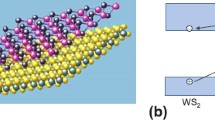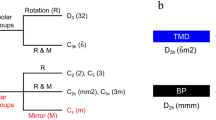Abstract
Photoinduced charge transfer (CT) is decisive to the efficiency and speed of photoelectric conversion in two-dimensional (2D) van der Waals (vdWs) heterostructures. Generally, CT rate enhancement is realized by increasing the band offset (BO). In this study, we propose that a fast and efficient CT can be realized via strong hybridization of energy levels in 2D vdWs heterostructures with minimal BO. First-principles calculations reveal that the smallest energy difference between conduction-band edges and minimal BO in the WS2/WxMo1−xS2 (x = 0.78) heterostructure yields the strong hybridization of energy levels and then results in ultrafast CT (2.7 ps). Experimental results agree with theoretical calculations. The photoluminescence of WS2 is quenched in the WS2/WxMo1−xS2 (x = 0.78) heterostructure, attributable to the strong hybridization-induced fast and efficient CT. This study provides insights into the mechanism of CT in heterostructures and offers new strategies to create superior optoelectronic devices with fast and efficient photoelectric conversion.
Similar content being viewed by others
References
Deng Y, Luo Z, Conrad N J, et al. Black phosphorus-monolayer MoS2 van der Waals heterojunction p−n diode. ACS Nano, 2014, 8: 8292–8299
Liu X, Wang W H, Yang F, et al. Bi2O2Se/BP van der Waals heterojunction for high performance broadband photodetector. Sci China Inf Sci, 2021, 64: 140404
Gong F, Luo W, Wang J, et al. High-sensitivity floating-gate phototransistors based on WS2 and MoS2. Adv Funct Mater, 2016, 26: 6084–6090
Lee I, Rathi S, Lim D, et al. Gate-tunable hole and electron carrier transport in atomically thin dual-channel WSe2/MoS2 heterostructure for ambipolar field-effect transistors. Adv Mater, 2016, 28: 9519–9525
Lee K H, Kim T H, Shin H J, et al. Highly efficient photocurrent generation from nanocrystalline graphene-molybdenum disulfide lateral interfaces. Adv Mater, 2016, 28: 1793–1798
Roy T, Tosun M, Cao X, et al. Dual-Gated MoS2/WSe2 van der Waals tunnel diodes and transistors. ACS Nano, 2015, 9: 2071–2079
Zhang K, Zhang T, Cheng G, et al. Interlayer transition and infrared photodetection in atomically thin type-II MoTe2/MoS2 van der Waals heterostructures. ACS Nano, 2016, 10: 3852–3858
Bai S, Jiang J, Zhang Q, et al. Steering charge kinetics in photocatalysis: intersection of materials syntheses, characterization techniques and theoretical simulations. Chem Soc Rev, 2015, 44: 2893–2939
Liu J, Chen S, Qian D, et al. Fast charge separation in a non-fullerene organic solar cell with a small driving force. Nat Energy, 2016, 1: 16089
Eisner F D, Azzouzi M, Fei Z, et al. Hybridization of local exciton and charge-transfer states reduces nonradiative voltage losses in organic solar cells. J Am Chem Soc, 2019, 141: 6362–6374
Tongay S, Fan W, Kang J, et al. Tuning interlayer coupling in large-area heterostructures with CVD-grown MoS2 and WS2 monolayers. Nano Lett, 2014, 14: 3185–3190
Zhang J, Hong H, Lian C, et al. Interlayer-state-coupling dependent ultrafast charge transfer in MoS2/WS2 bilayers. Adv Sci, 2017, 4: 1700086
Alexeev E M, Ruiz-Tijerina D A, Danovich M, et al. Resonantly hybridized excitons in moiré superlattices in van der Waals heterostructures. Nature, 2019, 567: 81–86
Sih G C. Electron cloud overlap related to specific energy threshold and breakdown at high temperature, short time and nano distance. Theor Appl Fract Mech, 2008, 50: 173–183
Louro P, Vieira M, Vygranenko Y, et al. Transport mechanism in high resistive silicon carbide heterostructures. Appl Surf Sci, 2001, 184: 144–149
van Hove M, Pereira R, de Raedt W, et al. Zero-dimensional states in submicron double-barrier heterostructures laterally constricted by hydrogen plasma isolation. J Appl Phys, 1992, 72: 158–160
Liu Y, Weiss N O, Duan X, et al. Van der Waals heterostructures and devices. Nat Rev Mater, 2016, 1: 16042
Yi Y, Coropceanu V, Brédas J L. A comparative theoretical study of exciton-dissociation and charge-recombination processes in oligothiophene/fullerene and oligothiophene/perylenediimide complexes for organic solar cells. J Mater Chem, 2011, 21: 1479
Kawatsu T, Coropceanu V, Ye A, et al. Quantum-chemical approach to electronic coupling: application to charge separation and charge recombination pathways in a model molecular donor-acceptor system for organic solar cells. J Phys Chem C, 2008, 112: 3429–3433
Chuang C H, Doane T L, Lo S S, et al. Measuring electron and hole transfer in core/shell nanoheterostructures. ACS Nano, 2011, 5: 6016–6024
Scholes G D, Jones M, Kumar S. Energetics of photoinduced electron-transfer reactions decided by quantum confinement. J Phys Chem C, 2007, 111: 13777–13785
Komsa H P, Krasheninnikov A V. Two-dimensional transition metal dichalcogenide alloys: stability and electronic properties. J Phys Chem Lett, 2012, 3: 3652–3656
Kang J, Tongay S, Li J, et al. Monolayer semiconducting transition metal dichalcogenide alloys: stability and band bowing. J Appl Phys, 2013, 113: 143703
Xi J, Zhao T, Wang D, et al. Tunable electronic properties of two-dimensional transition metal dichalcogenide alloys: a first-principles prediction. J Phys Chem Lett, 2013, 5: 285–291
Zhang W, Li X, Jiang T, et al. CVD synthesis of Mo(1−x)WxS2 and MoS2(1−x)Se2x alloy monolayers aimed at tuning the bandgap of molybdenum disulfide. Nanoscale, 2015, 7: 13554–13560
Wang Z, Liu P, Ito Y, et al. Chemical vapor deposition of monolayer Mo1−xWxS2 crystals with tunable band gaps. Sci Rep, 2016, 6: 21536
Liu X, Wu J, Yu W, et al. Monolayer WxMo1−xS2 grown by atmospheric pressure chemical vapor deposition: bandgap engineering and field effect transistors. Adv Funct Mater, 2017, 27: 1606469
Gong C, Zhang H, Wang W, et al. Band alignment of two-dimensional transition metal dichalcogenides: application in tunnel field effect transistors. Appl Phys Lett, 2013, 103: 053513
Kang J, Tongay S, Zhou J, et al. Band offsets and heterostructures of two-dimensional semiconductors. Appl Phys Lett, 2013, 102: 012111
Taube H. Electron transfer between metal complexes—a retrospective view (nobel lecture). Angew Chem Int Ed Engl, 1984, 23: 329–339
Sutin N. Theory of electron transfer reactions: insights and hindsights. In: Progress in Inorganic Chemistry: An appreciation of Henry Taube. Hoboken: John Wiley & Sons, Inc., 1983. 441–498
Taube H. Electronic coupling mechanisms in mixed-valence molecules. Ann NY Acad Sci, 1978, 313: 481–495
Carraway E R, Demas J N, DeGraff B A. Luminescence quenching mechanism for microheterogeneous systems. Anal Chem, 1991, 63: 332–336
Sariciftci N S, Smilowitz L, Heeger A J, et al. Photoinduced electron transfer from a conducting polymer to buckminster-fullerene. Science, 1992, 258: 1474–1476
Wang J, Wang D, Miller E K, et al. Photoluminescence of water-soluble conjugated polymers: origin of enhanced quenching by charge transfer. Macromolecules, 2000, 33: 5153–5158
Merkl J P, Wolter C, Flessau S, et al. Investigations of ion transport through nanoscale polymer membranes by fluorescence quenching of CdSe/CdS quantum dot/quantum rods. Nanoscale, 2016, 8: 7402–7407
Ji Z, Hong H, Zhang J, et al. Robust stacking-independent ultrafast charge transfer in MoS2/WS2 bilayers. ACS Nano, 2017, 11: 12020–12026
Yu Y, Hu S, Su L, et al. Equally efficient interlayer exciton relaxation and improved absorption in epitaxial and nonepitaxial MoS2/WS2 heterostructures. Nano Lett, 2015, 15: 486–491
Yang R, Zheng X, Wang Z, et al. Multilayer MoS2 transistors enabled by a facile dry-transfer technique and thermal annealing. J Vac Sci Technol B, 2014, 32: 061203
Acknowledgements
This work was supported by National Key Research and Development Program of China (Grant Nos. 2019YFA0308000, 2017YFA0205700, 2017YFA0204800), National Natural Science Foundation of China (Grant Nos. 61927808, 61774034, 21525311, 91963130, 62174026), Jiangsu Province Basic Research Plan (Grant No. BK20170694), Strategic Priority Research Program of Chinese Academy of Sciences (Grant No. XDB30000000), and Fundamental Research Funds for the Central Universities.
Author information
Authors and Affiliations
Corresponding authors
Additional information
Supporting information
Appendix A. The supporting information is available online at info.scichina.com and link.springer.com. The supporting materials are published as submitted, without typesetting or editing. The responsibility for scientific accuracy and content remains entirely with the authors.
Electronic Supplementary Material
Rights and permissions
About this article
Cite this article
An, X., Zhang, Y., Yu, Y. et al. Efficient charge transfer in WS2/WxMo1−xS2 heterostructure empowered by energy level hybridization. Sci. China Inf. Sci. 66, 122404 (2023). https://doi.org/10.1007/s11432-022-3465-2
Received:
Revised:
Accepted:
Published:
DOI: https://doi.org/10.1007/s11432-022-3465-2




